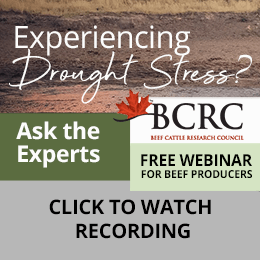Experts Respond to Drought Questions
On July 29, the Beef Cattle Research Council hosted a webinar that allowed beef producers to ask drought-related questions to a panel of nutrition and animal health experts. Producers asked for everything from recommendations for grazing canola, how to manage for antinutritional factors, tips on ammoniation and to how to manage grass into the fall. While questions were varied and diverse, a few main themes emerged.
Feed testing:
In a drought year, testing your feed sources is more important than ever. Especially when using alternative feed sources, a feed test allows you to understand what you have in terms of energy and protein and therefore what you will need to supplement to maintain the health and body condition of cows and other classes of cattle. A feed test will also identify some of the antinutritional factors and potential toxic levels of substances such as nitrates or sulfates that are more prevalent in drought years or unconventional feeds. Feed tests can be performed on standing or swathed crops, bales or silage. A feed test can be instrumental in determining how a particular feed will fit into your overall feeding strategy.
Water testing:
With hot dry conditions water conditions can change rapidly. As water evaporates it leaves behind the minerals and other compounds that can be problematic, toxic, or result in death or dehydration. Water should be tested frequently during drought and cattle should be monitored more closely. For example, one of the first warning signs of high sulfates is that cattle will refuse to drink the water. It is important to monitor cattle and remove them from the water source if you see signs that cattle have not been drinking. Depending on what levels of mineral(s) or toxin(s) are present in the water source, aeration or diluting the water with a clean water source may help mitigate the concerns.
Be aware of additive effects and interactions:
Even if feed and water sources are each within tolerable levels for potential toxins like nitrates or sulfates, remember that cattle consume both water and feed. The combination of the two could have additive effects resulting in negative animal health consequences or even death. This is even more important with alternative feed sources. For example, canola tends to be naturally high in sulfates. If you are feeding salvaged canola but your water source is also high in sulfates, the combination can result in overexposure. Cattle may show immediate signs of sulfur toxicity (such as neurological symptoms like twitching, vison impairment or staggering). Mineral interactions can also ensue. For example, copper levels may be acceptable in both the water and the feed, but excess sulfates (or molybdenum) can tie up that copper and result in a lower pregnancy rates next year, or tie up vitamin E and selenium increase the risk for white muscle disease in calves next spring. There may be enough nutrient in the feed, but if that nutrient is bound up by another feed ingredient and can’t be absorbed or used by the animal, it will still be deficient. This is known as a secondary deficiency.
Take caution when feeding weeds:
Listen to Dr. Bart Lardner’s response at 35:45 about weeds to graze or avoid.
Certain weeds (including dandelion, lambs quarter, and kochia) can be very nutritious for cattle, but use caution. Kochia tends to be high in oxalates, which can bind calcium and result in a secondary calcium deficiency (again, the feed test result may indicate that calcium levels in the ration are adequate). Make sure you are aware of poisonous weeds in your area. Often cattle will avoid grazing these plants in normal years, but cattle may start to graze those poisonous species in drought conditions when forage supplies are short.
A few other points to consider:
- Avoid grazing flax, it is also high in oxalates and can bind copper. If you plan on feeding flax, it is better to cut and bale it.
- When grazing salvaged feeds, make sure you are aware of any products that have been used on that crop. Fungicides, herbicides or other chemicals used on crops may have withdrawal dates for livestock consumption or may state that livestock should not graze the crop at all.
- Ammonization can be used to increase the protein content of straw. If using ammoniated feed the ration must be balanced to ensure adequate energy for cattle to digest the protein. Availability of crews can also be an issue and appropriate safety precautions must be taken.
- When grazing alternative feeds or residues, use electric fence to only allow access to small amounts of the field at a time. This will help cattle graze more efficiently but also can make supplementation easier.
- Consider weaning calves early to reduce the energy requirements of the cow herd. Ensure you run the numbers to decide what the best option is when it comes to marketing calves.
Watch the full webinar recording for more in-depth answers, tips, tricks and solutions to managing cattle in drought conditions.
Click here to subscribe to the BCRC Blog and receive email notifications when new content is posted.
The sharing or reprinting of BCRC Blog articles is welcome and encouraged. Please provide acknowledgement to the Beef Cattle Research Council, list the website address, www.BeefResearch.ca, and let us know you chose to share the article by emailing us at info@beefresearch.ca.
We welcome your questions, comments and suggestions. Contact us directly or generate public discussion by posting your thoughts below.
